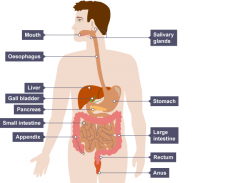![]()
![]()
![]()
Use LEFT and RIGHT arrow keys to navigate between flashcards;
Use UP and DOWN arrow keys to flip the card;
H to show hint;
A reads text to speech;
6 Cards in this Set
- Front
- Back

Human Digestive System |
What is the Human Digestive System? It is when the food we eat has to be broken down into other substances that our bodies can use. This is called digestion. Without digestion, we could not absorb food into our bodies and use it. Digestion happens in the digestive system, which begins at the mouth and ends at the anus. |
|
|
After we swallow, our food passes through these organs in turn: ... |
.oesophagus or gullet
.stomach .small intestine .large intestine |
|
|
Stages of digestion
|
Different things happen to food as it passes through the digestive system:
.Food is digested in the mouth, stomach and small intestine .Digested food is absorbed into the bloodstream in the small intestine .Excess water is absorbed back into the body in the large intestine .Any undigested food passes out of the anus as faeces when we go to the toilet |
|
|
Liver and pancreas
|
How do they work? The liver and the pancreas play an important part in digestion. The liver produces bile, which helps the digestion of lipids (fats and oil). The pancreas produces biological catalysts called digestive enzymes which speed up the digestive reactions. |
|
|
Enzymes
|
Enzymes are not living things. They are just special proteins that can break large molecules into small molecules. Different types of enzymes can break down different nutrients:
.Amylase and other carbohydrates enzymes break down starch into sugar .Protease enzymes break down proteins into amino acids .Lipase enzymes break down lipids (fats and oils) into fatty acids and glycerol |
|
|
Carbohydrates
|

Carbohydrates are digested in the mouth, stomach and small intestine. Carbohydrase enzymes break down starch into sugars.The saliva in your mouth contains amylase, which is another starch digesting enzyme.
|

